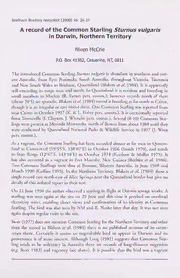
A record of the Common Starling Sturnus vulgaris in Darwin, Northern Territory PDF
Preview A record of the Common Starling Sturnus vulgaris in Darwin, Northern Territory
Northern Territory Naturalist (2000) 16; 26-27 A record of the Common Starling Sturnus vulgaris in Darwin, Northern Territory Niven McCrie P.O. Box 41382, Casuarina, NT, 0811 The introduced Common Starling Sturnus vulgaris is abundant in southern and east¬ ern Australia, from Eyre Peninsula, South Australia, throughout Victoria, Tasmania and New South Wales to Brisbane, Queensland (Blakers et al. 1984). It is apparently still extending its range west and north. In Queeii-sland it is resident and breeding in small numbers in Mackay (R. Fames pers. comm.); however records north of there (about 20'’S) are sporadic. Blakers et al. (1984) record it breeding as far north as Cairns, though it is an irregular or rare visitor there. One Common Starling was reported from near Cairns in October 1997 (K. & L. Fisher pers. comm.). It is occasionally reported from Townsville (1. Clayton, J. Wieneke pers. comm.). Several (8-10) Common Star¬ lings were present at Merinda Meatworks, north of Bowen from about 1988 until they were eradicated by Queensland National Parks & Wildlife Service in 1997 (J. Wren pers. comm.). As a vagrant, the Common Starling has been recorded almost as far west in Queens¬ land as Camooweal (19"55’S, 138"07’E) in October 1966 (Smith 1970), and north to Iron Range (12"47’S, I43'T8’E) in October 1974 (Forshaw & Muller 1975). It has also occurred as a vagrant in Port Moresby, New Guinea (Beehicr et al. 1986). Two Common Starlings were .shot at Broome, Western Australia, in June 1988 and March 1990 (Collins 1995). In the Northern Territory, Blakers et al. (1984) show a single record east north-east of Alice Springs near the Queensland border but give no details ol this isolated report in their text. On 22 June 1996 the author observed a starling in flight at Darwin .sewage works. A starling was seen again at the site on 29 June and this time it perched on overhead electricity wires, enabling closer views and confirmation of its identity as Common Starling. The bird was al.so seen by NM and R. Noske later that day. It was not seen again despite regular visits to the site. Storr (1977) does not mention Common Starling for the Northern Territory and other than the record in Blakers et al. (1984) there is no publLshed account of its occur¬ rence there. Certainly it seems an improbable bird to appear in Darwin and its provenance is of .some interest. Although Long (1981) suggests that Common Star¬ ling tends to be sedentary in Australia there are records of long-distance migration {e.g. Storr 1983) and vagrancy (see above). It is possible that the bird was a vagrant Northern Territory Naturalist 16 (2000) 27 from the northern hemisphere, where tlie species has been recorded as a non-breed¬ ing visitor as far south as central Thailand (Lekagtil & Round 1991). However such birds would be expected to show eclipse plumage whereas the Darwin bird was in breed¬ ing plumage, which is more consistent with Australian birds for that time of year. Thus it seems most likely that the bird arrived as a transported migrant, by ship or road transport from the .south-ea.st of Australia. There is little evidence to suggest that Common Starling pose an invasive threat to tropical areas of the Northern Territory, especially given the paucity of records from northern Australia. The most ‘tropical’ resident population appears to be in Jamaica (c. 18'’N; Bond 1990). The species is a winter visitor in Mexico as far south as Veracruz (also c. 18'’N; Davis 1972). In the Pacific, Common Starling has become established on some of the southern Lati islands of Fiji (c. 20"S; Clunie 1984) but it has not colo¬ nised more northerly areas of the south-west Pacific (Clunie 1984, Bregulla 1992, Watling 1982). Acknowledgements 1 am gratelul to Richard Noske for commenting on a draft of this note and to Roger Jaensch for his help in finding references. References Bond j. (1990) Birds of the West Indies. Collins, London. Beehler B.M, Pratt T.K. and Zimmerman D.A. (1986) Birds of New Guinea. Princeton University Press, New Jersey. Blakers M., Davies S.J.J.F. and Reilly P.N. (1984) The atlas of Australian birds. Melbourne University Press, Melbourne. Bregulla H.I.. (1992) Birds of Vanuatu. Anthony Nelson, UK. Clunie F. (1984) Birds of the Fiji bush. Fiji Museum. Suva. Collins P. (1995) The birds of Broome. Broome Bird Observatory, Broome. Davis L. (1972) A field guide to the birds of Mexico and Central America. University of Texas Press, Aimin &C London. Forshaw j.M. and Muller K.A. (1975) The Fiuropean Starling in Northern Queensland. Australian Bird Watcher 6, 86. Lekagul B. and Round P.D. (1991) d guide to the birds of Thailand. Saha Karn Bhaet, Bangkok. Long J.L. (1981) Introduced birds of the World. Reed, Sydney. Smith F.'L.H. (1970) European Starling in north-west Queensland. Australian Bird Watcher ?>, 237. Storr G.M. (1977) Birds of the Northern Territory. Special Publication No. 7, Western Australian Museum, Perth. Storr G.M. (1983) List of Queensland birds. Special Publication No. 5, Western Australian Museum, Perth. Watling D. (1982) Birds of Fiji, Tonga and Samoa. Millwood Press, Wellington.
